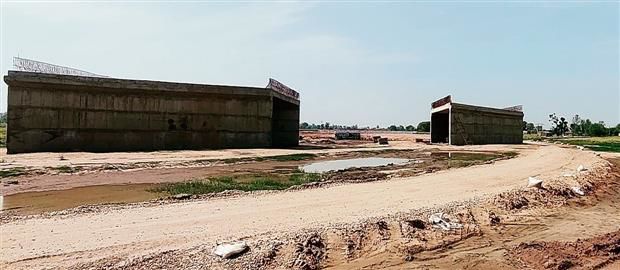Eight years on, Delhi-Amritsar-Katra expressway remains distant dream
Nitin Jain
Ludhiana, July 15
The 650-kilometer Delhi-Amritsar-Katra expressway has captured the attention of the Prime Minister.
Reason: Even after eight years, this long-awaited and delayed four-lane access-controlled highway with a route alignment connecting Jasaur Kheri in Jhajjar district near Delhi to Katra north of Jammu remains a distant dream.
The inordinate delay has increased the National Highways Authority of India (NHAI) project cost from Rs 25,000 crore to Rs 35,406 crore, as none of the 17 packages (sections) and 3 spurs of this mixed brownfield and greenfield motorway have been completed.
Caught up in the land acquisition hurdles across several northern states where the farmers are not allowing possession of their land for want of more compensation, this is one of the flagship projects of the NHAI.
Taking cognisance of the matter, the PM has called a meeting in New Delhi on July 31 to take stock of the current situation and decide on the future course of action.
Before his meeting, the Road Transport and Highways Minister, Nitin Gadkari, will also review the status of the stalled NHAI projects in Punjab, at a two-day meeting scheduled for today and tomorrow.
In a slide presentation, a copy of which is with The Tribune, which would be presented before the PM and Gadkari, the NHAI and Ministry officials have put on record the current status of each project with its cost and the targeted date of completion.
According to the presentation, the progress of Delhi-Amritsar-Katra expressway has been the most dismal, ranging between 3 and 90 per cent for the multiple packages and spurs, eleven of which fall in the state.
The progress report revealed that package 1 has so far achieved 86.34 per cent physical progress, two 82.05 per cent, three 83.76 per cent, four 79.95 per cent, five 56.02 per cent, six 89.98 per cent, seven 75.87 per cent, eight 23.06 per cent, nine 47.2 per cent, ten 46.52 per cent, eleven 34.45 per cent, twelve 3.58 per cent, fourteen 45 pc, fifteen 59.02 pc, sixteen 50.11 pc, seventeen 10.96 pc, eighteen 4.59 pc and spur 1 has clocked 6.58 pc while spur 2 and 3 have progressed 13.8 pc each.
The revised target dates of completion fixed by the NHAI showed that package 1 and 2 are likely to be built by August 31, while the package 3, 4, 5, 6, 7, 9 and 10 have also missed their fresh deadlines fixed for March 31 (for 3 and 4), May 22 and 21 (5 and 6), July 9 (7, 10) and July 16 for package 9.
While package 11 and spur 2 and 3 are also set to miss their deadlines on November 13, December 30 and October 26, respectively, the fresh deadlines for package 12 has been fixed on December 30 next, 14 and 15 on July 31 next, 16 on December 31 next, 17 on August 31 next, 18 November on 19 next, and spur 1 has been targeted to be built by April 16, 2026.
Large part in Punjab: The 361.656-km proposed length of the 650-km-long expressway falls in Punjab. The project’s greenfield section comprises 15 packages, including 12 on the 397-km Delhi-Gurdaspur section and three on the 99-km Nakodar-Amritsar spur.
According to the project report, the Punjab section of the 650-km expressway begins from near Galoli village in Patiala and ends at Gurdaspur bypass. The proposed Amritsar greenfield connectivity starts from Nakodar and ends near the canal on Amritsar-Ajnala road.
The project alignment of Punjab section passes through Ludhiana, Patiala, Sangrur, Jalandhar, Kapurthala and Gurdaspur districts while the alignment of greenfield connectivity to Amritsar crosses through Jalandhar, Kapurthala, Tarn Taran and Amritsar districts.
To cut distance, travel time:
The expressway will reduce the distance between Delhi, Amritsar and Katra by about 40-km and provide a travel time from Delhi to Amritsar of 4-4.5-hours and Delhi to Katra of 6-6.5-hours.
Since the four-lane access-controlled road expandable to 8 lanes being developed under the hybrid annuity model (HAM) passes through Punjab, Haryana, and Jammu, it will provide the shortest connectivity to industrial and economic hubs of Ludhiana, Mohali, Patiala, Jalandhar, Kapurthala, Sangrur in Punjab; Ambala in Haryana; Kathua, Jammu in Jammu and Kashmir, and Chandigarh.
After the long-distance vehicular traffic shifts from existing national highways to the new expressway, resulting in lesser congestion leading to higher fuel savings and reduced travel time, the freight movement will also speed up and road safety of the traffic connecting the region will be enhanced.
To connect Sikh shrines, Kartarpur Corridor
It will also provide the faster route to important Sikh shrines at Sultanpur Lodhi, Goindwal Sahib, Khadoor Sahib, Tarn Taran, and the recently developed Dera Baba Nanak-Kartarpur Sahib international corridor.









